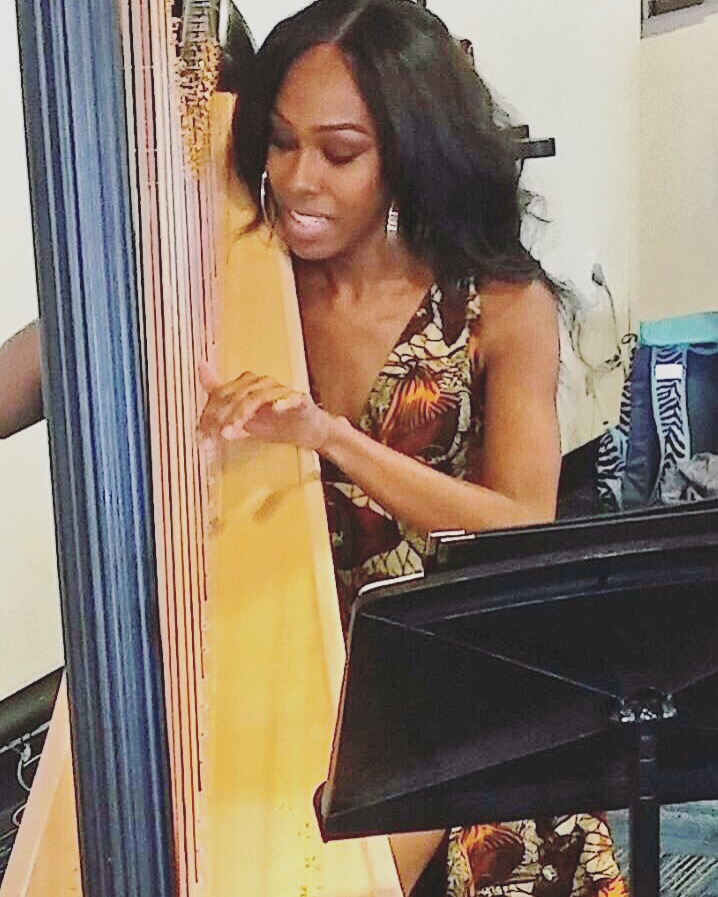This transgender woman uses her unique voice to advocate for herself and her community.
This is part of a story series about the lives of transgender people. Read the introduction here.
 Ahya Simone didn’t plan on becoming a harpist.
Ahya Simone didn’t plan on becoming a harpist.
She’s always been musical and had long been a singer, but taking a harp class began as nothing more than a way to fill a hole in her schedule. In fact, she initially had so little interest she thought she’d drop the class.
But then she fell in love.
Although it was a bold instrument — pretty and elegant and unique — not many people I knew played the harp. So I felt like it was a nice outlet for my gender identity. It was really helpful in coming to terms with living in my truth. The harp was integral and important in my life during the time of a lot of turmoil and uncertainty and trying to find myself.
It’s impossible not to see the parallels between Simone and the harp: pretty, elegant, unique. And if the harp is a bold instrument, the same could be said for the decision Simone made to live authentically as female, even though she was assigned male gender at birth. It’s a decision that takes great courage, no matter who you are.
When she was younger, the 23-year-old Simone says she simply knew herself to be herself. But she learned very quickly that being herself really wasn’t allowed.
“When we’re born, we’re not born with knowledge of these labels that we place on our body, these expectations,” she says. “The expectations that were placed upon me based on my assigned gender just weren’t me, and I wasn’t allowed to express who I truly am to the world, to society. I learned early on I could only survive if I played into these gender expectations or rituals we ascribe folks.”
Simone says people would police her gender expression or mannerisms, including her family, when she presented feminine characteristics. She says there was a lot of trauma associated with not being able to express her true self, something that’s common among many transgender people.
Although I knew these ideas — these expectations — didn’t fit me, I internalized them because there was no other way I could survive and navigate society. It made me feel isolated and othered, and it left me without a lot of emotional support.
Coming to terms with her attraction to masculine people in high school, when she was still presenting as male, was an important step, Simone says. But it was just the beginning.
“I also realized that I could really be free and happy by just expressing myself,” she says. “That was a catalyst, but it wasn’t until my senior year in high school that I realized trans people existed, that other people spoke similarly or shared a commonality of dysphoria.”
Once Simone realized that other people shared her sense of dysphoria — feeling disconnected to the gender one is assigned at birth — it helped her find the courage to begin transitioning during her freshman year at Wayne State University in Detroit.
She was studying harp performance and says the music department was very affirming, which undoubtedly helped her succeed in her pursuit of the music performance degree she earned in 2014. She played professionally in college and was part of the WSU Wind Symphony, which frequently performed at the Max M. Fisher Music Center.
But outside the music department, Simone found far less encouragement for her transition. Because she hadn’t legally changed her name or any of her documents, she encountered a lot of transphobia. She was continually assigned male roommates, which made her increasingly uncomfortable.
That discomfort ignited her activism.
There was very little support for transitioning students. I was kind of tossed by the wayside. I had to constantly email and follow up with heads of housing. Sophomore year I didn’t have a roommate because I kept complaining so much.
I had some support from friends, but not much. I was really isolated, especially being the only open black trans woman on campus for that four years, navigating a largely cisgender white space. It made the work a little harder to accomplish, not knowing who to trust to help me.
So Simone did the one thing she knew could bring about change: She spoke out.
“I had to be a voice. It was necessary for my survival to speak out,” she says. “I spoke because I had to — because my silence would have killed me, literally and figuratively. It was important to let my voice be heard.”
Simone spoke out not only for herself, but for all the other trans women of color in Detroit and beyond.
There are issues that come with being black and trans and female — the disenfranchisement trans women of color have to go through, dealing with survival economies, under-employment, unemployment, being under- and uneducated, sometimes undocumented and poor. Trans women operate at those intersections all the time. It’s important to speak up and speak out.
So many institutions keep trans women subjugated. I feel like a lot of times we trans women don’t have anything to lose. Being silent isn’t helping us. Being silent won’t save us, because otherwise it will be business as usual. We’ll continue to be left without.
Simone’s passion led to her become a co-founder, with Bré Anne Campbell, of the Trans Sistas of Color Project in Detroit. Because it’s still an emerging organization, she wears many different hats to get the work done — “work that affirms trans people,” as Simone says.
She also works at Affirmations in Ferndale as the volunteer coordinator, in addition to working with UNIFIED – HIV Health and Beyond as a PrEP specialist. In all of her endeavors, Simone recognizes how much work is still left to do, especially in regard to healthcare access for transgender people.
We need to get people the care they need. A lot of times with healthcare, they’re also gatekeepers of everyone’s care — they tell you what they’re going to pay for and what they won’t. People who don’t reflect our lived experience conclude that what we say we need for survival is simply cosmetic or not as necessary. That’s a dangerous viewpoint and it’s killing us.
 Since college, Simone’s network of support has expanded significantly, and now includes her family, who struggled at first to accept her transition to who she really is.
Since college, Simone’s network of support has expanded significantly, and now includes her family, who struggled at first to accept her transition to who she really is.
Simone also had a significantly affirming experience a couple of years ago. She was hired as a model for Barneys New York’s Spring 2014 campaign, which featured the photos and stories of transgender people. She was photographed by the iconic Bruce Weber and featured in the March 2014 issue of Vogue magazine.
And she continues expressing herself through her music, working as a freelance harpist who has a unique vision for her instrument.
“I’m classically trained but I am working on branching out and doing more R&B, maybe funk, or just various ways to break out,” Simone says. “I am really interested in showing the world what the harp can do.”
Read all the stories in this series HERE.
[Photo courtesy of Ahya Simone.]



